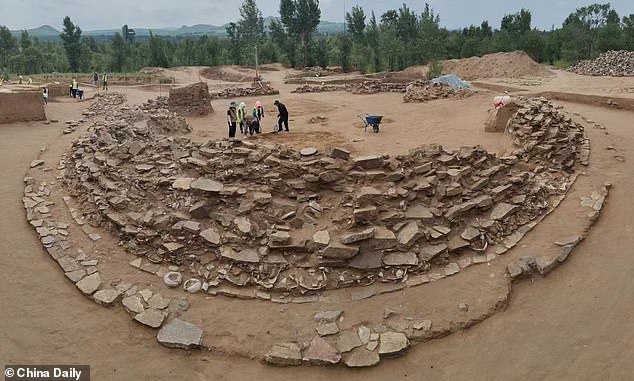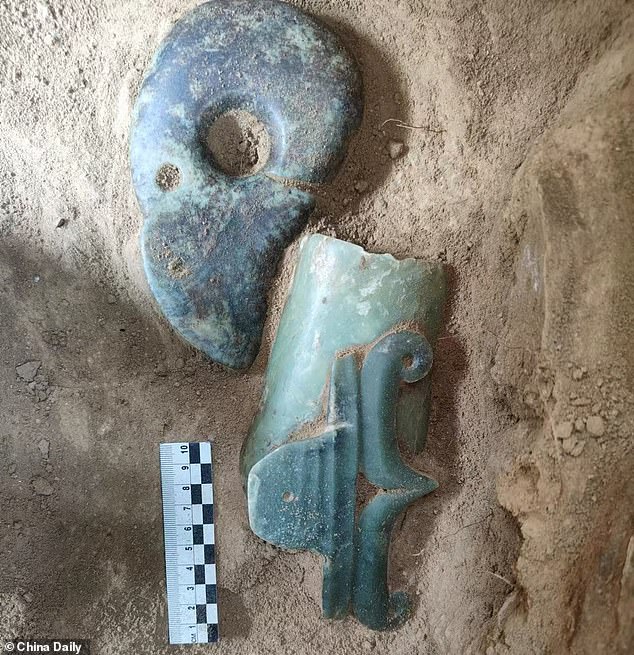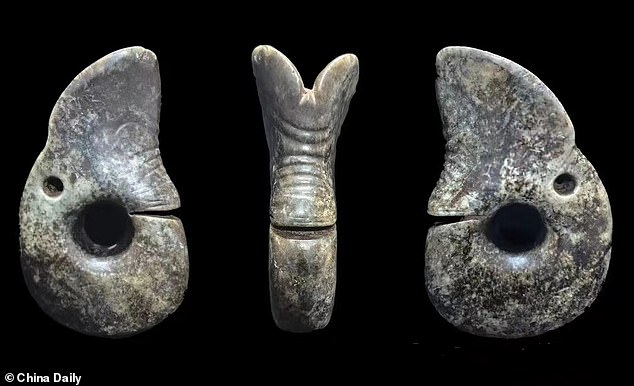A 5,000-year-old discovery made in an ancient cemetery in northern China could finally reveal how Chinese civilizations were formed.
Archaeologists unearthed more than 100 jade relics in the city of Chifeng, including three dragons, the largest of which was about half a foot long.
The elaborate burial site consisted of a circular tomb and a sacrificial altar, revealing the prehistoric culture of the Hongshan people who lived in the region around 3000 BC.
The relics were similar to ancient artifacts previously found in other provinces and suggested that the Hongshan culture was inspired by three other societies living at least 100 miles away.
Archaeologists found three dragons among 100 jade relics in an ancient cemetery in China

The relics were found beneath a circular tomb at the Yuanbaoshan burial site.
The team determined that the Hongshan civilization may have exchanged artistic ideas with the Yangshao and Liangzhu cultures.
Researchers from the Institute of Archeology of the Chinese Academy of Social Sciences recovered the jade relics at the Yuanbaoshan burial site, along with ruins, ceramics and human remains.
Three dragons were among the relics excavated beneath the walls of the circular tomb that measured about 77 feet in diameter.
Jade dragons were stockier and more stubborn in appearance than those made today.
In China, jade dragons have long been a symbol of good luck, protection from evil spirits and were believed to connect the physical and spiritual realms after death.
The team was surprised to find the six-inch jade dragon that was slightly longer than the one unearthed 150 kilometers away in Liaoning province.
They also identified several stone structures and half-buried houses at the burial site, which were probably Tombs for high-ranking people.
And the altars were used to perform religious ceremonies.
Historically, the Hongshan culture practiced a variety of religious ceremonies, including burying their dead on ceremonial platforms alongside carved jade, and had a unique sacrificial system that involved using dragon artifacts to worship their ancestors.
Jia Xiaobing, a researcher at the Chinese Institute of Archaeology, confirmed that the design of the tomb is similar to those found in Niuheliang, a town about 140 kilometers away.

The jade dragon (pictured), measuring more than six inches long, is the largest ever unearthed.

Researchers hope the discovery will reveal how China’s ancient civilizations communicated and shared artistic styles.
It was identified by its southern circle, northern altar and northern tomb design and the jade artifacts also revealed a crossover of stylistic similarities used in other cultures, representing a connection for the first time.
Dang Yu, a research librarian at the Inner Mongolia Institute of Archeology and Cultural Relics, said the jade relics also included ceremonial tools and ornaments, axes and headdresses.
One piece of headdress resembled those belonging to the Lingjiatan culture from 5,300 to 5,800 years ago in present-day Anhui province, further demonstrating that the two cultures had cultivated long-distance cultural trade.
“Such coherence over a wide area demonstrates that a shared belief system existed among Hongshan ancestors,” Xiaobing said. Chinese Newspaper.
Hongshan culture sites have been found dating back to between 4700 BC and 4700 BC. C. and 2900 BC. C. that extend from Inner Mongolia to Liaoning in the northern region of the country.
Researchers are conducting additional tests and studies to learn more about the relics and when the burial site was built.


